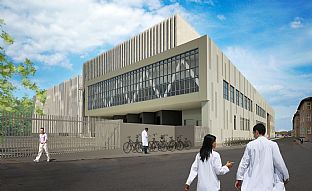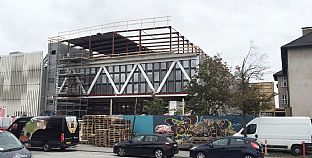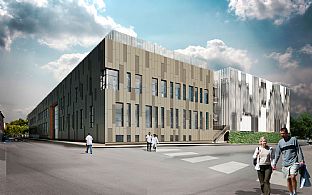
Rigshospitalet's new fully-automated sterilisation centre will be the first of two such centres in the Capital Region, with the other being established at Herlev Hospital. Rigshospitalet's sterilisation centre will at the same time become the first fully-automated sterilisation centre in the world, with the concept anticipated to set the gold standard for future sterilisation centres both in Denmark and overseas.
The concept was created in collaboration between the architecture firm C.F. Møller, with extensive experience in the development of future healthcare development all over Scandinavia, the engineering firm ALECTIA, one of Denmark's foremost advisers in the hospital field, and the Capital Region, which operates and develops the Capital's healthcare sector.
The purpose of the sterilisation centre is to safeguard that the sterilisation of instruments and operation theatre equipment in future will live up to national and international guidelines for the re-treatment of sterile medical equipment. The solution is a combination of pioneering technology, automated by robots and familiar elements, merged in a new manner.
Interaction with the environment
The sterilisation centre consists of four floors combined with a new freight terminal in the ground and basement levels. The actual sterilisation of instruments will take place on the first floor of the building, whilst reception, distribution and packaging of goods takes place on the ground floor. The top floor of the building houses technical equipment.
The façade consists of aluminium panelling with differentiated surface treatments in combination with partial sections with punched details, to create a varied façade impression, which changes with the the viewer's movement, as well as the impression changes with the motion of the sun. The building forms part of a subtle interaction with the opposing psychiatry buildings with plastered façades, whilst the sterilisation centre is part of an architectural interplay with a significant multi-storey car park, adjacent to the sterilisation centre.
State-of-the-art technology
The new sterilisation centre enables numerous work processes to be centralised, which to a greater extent than previously are based on automated processes and robotics. In addition to optimising patient safety and the working environment, the new sterilisation centre will create conditions for the highest possible levels of uniformity and product quality, increase productivity through economies of scale and ensure rapid adaptation to new re-treatment forms, staff development and training, etc.
Additionally when the sterilisation is ready the employees' working methods will change significantly. The concept involves a holistic automation of virtually all heavy and repetitive workflows through the use of robotics, mini AGVs and conveyor systems.
"We are very pleased with the collaboration with ALECTIA and the Capital Region, in which we contribute our focus on healing architecture in the more logistical and technically-oriented parts of a modern hospital, bringing major focus on to a good working environment with daylight and spatial qualities. Even though there is talk of integrating state-of-the-art technology with hitherto unprecedented automation, it is also a workplace with control, adjustments and manual processes," explains Klaus Hyttel, partner and architect at C. F. Møller.
A total of 1.2 billion kroner invested in the establishment of a sterilisation centre at Rigshospitalet and Herlev Hospital. The two sterilisation centres will together cover the need for sterilised surgical instruments and other sterile equipment needed in a hospital environment. Rigshospitalet's sterilisation centre is expected to stand ready in 2017 and Herlev Hospital's sterilisation centre in 2018. Thereafter re-treatment equipment and automation will be run-in.
Contact: C.F. Møller and ALECTIA







